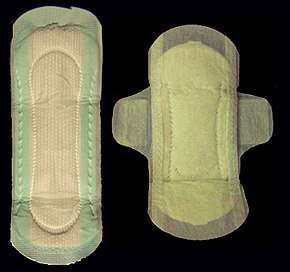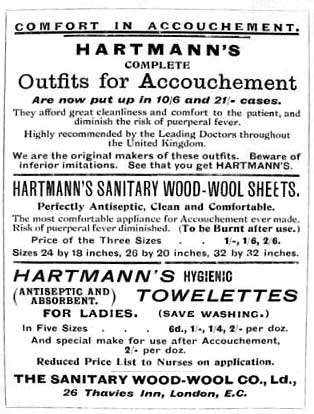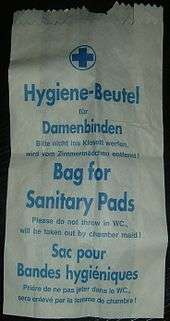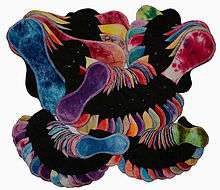Sanitary napkin

A sanitary napkin, sanitary towel, sanitary pad, menstrual pad, or pad is an absorbent item worn by a woman while she is menstruating, while she is recovering from vaginal surgery, for lochia (post-birth bleeding), after an abortion, or in any other situation where it is necessary to absorb a flow of blood from the vagina.[1]
These pads are not to be confused with generally higher absorbency incontinence pads, which are worn by men or women who have urinary incontinence problems or experience stress incontinence. Menstrual pads may be used by some people for this purpose.
History


Through the ages women have used different forms of menstrual protection.[2][3] Menstrual pads have been mentioned as early as the 10th century, in the Suda, where Hypatia, who lived in the 4th century AD, was said to have thrown one of her used menstrual rags at an admirer in an attempt to discourage him.[4][5] Women often used strips of folded old cloth (rags) to catch their menstrual flow, which is why the term "on the rag" is used to refer to menstruation.
Disposable menstrual pads grew from a Ben Franklin invention created to help stop wounded soldiers from bleeding,[6]but appear to have been first commercially available from around 1888 with the Southall's pad.[7] The first commercially available American disposable napkins were Lister's Towels created by Johnson & Johnson in 1888. Disposable pads had their start with nurses using their wood pulp bandages to catch their menstrual flow, creating a pad that was made from easily obtainable materials and inexpensive enough to throw away after use.[8] Kotex's first advertisement for products made with this wood pulp (Cellucotton) appeared in 1888.[9] Several of the first disposable pad manufacturers were also manufacturers of bandages, which could give an indication of what these products were like.
Until disposable sanitary pads were created, cloth or reusable pads were widely used to collect menstrual blood. Women often used a variety of home-made menstrual pads which they crafted from various fabrics, or other absorbent materials, to collect menstrual blood.[2][10] Even after disposable pads were commercially available, for several years they were too expensive for many women to afford.[11] When they could be afforded, women were allowed to place money in a box so that they would not have to speak to the clerk and take a box of Kotex pads from the counter themselves.[9] It took several years for disposable menstrual pads to become commonplace. However, they are now used nearly exclusively in most of the industrialized world.[11]
The first of the disposable pads were generally in the form of a cotton wool or similar fibrous rectangle covered with an absorbent liner. The liner ends were extended front and back so as to fit through loops in a special girdle or belt worn beneath undergarments. This design was notorious for slipping either forward or back of the intended position.
Later an adhesive strip was placed on the bottom of the pad for attachment to the crotch of the panties, and this became a favoured method with women. The belted sanitary napkin quickly disappeared during the early 1980s.
The ergonomic design and materials used to make pads also changed through the 1980s to today. With earlier materials not being as absorbent and effective, and early pads being up to two centimetres thick, leaks were a major problem. Some variations introduced were quilting of the lining, adding "wings" and reducing the thickness of the pad by utilising products such as sphagnum and polyacrylate superabsorbent gels derived from petroleum. The materials used to manufacture most pads are derived from the petroleum industry and forestry. The absorbent core, made from chlorine bleached wood pulp, could be reduced to make slimmer products with the addition of polyacrylate gels which sucks up the liquid quickly and holds it in a suspension under pressure. The remaining materials are mostly derived from the petroleum industry, the cover stock used is polypropylene non woven, with the leakproof barrier made from polyethylene film.
Cloth menstrual pads made a comeback around the 1970s,[12] with their popularity increasing in the late 80s and early 90s. Reasons women choose to switch to cloth menstrual pads include comfort, savings over time, environmental impact and health reasons.
There are many styles of cloth menstrual pads available today, ranging from pantyliners to overnight pads. Popular styles of cloth menstrual pads include all-in-one, or AIO pads, in which the absorbent layer is sewn inside the pad, 'inserts on top' style pads, which have absorbent layers that can be secured on top of the pad as needed, envelope or pocket style pads, which have absorbent layers that can be inserted inside the pad as needed, and a foldable style, in which the pad folds around the absorbent layers. Cloth menstrual pads can have waterproof lining, which provides more leak protection but may also be less breathable.
In underdeveloped countries, reusable or makeshift pads are still used to collect menstrual blood.[13] Rags, soil, and mud are also reportedly used for collecting menstrual flow.[14]
In order to meet the need for achieving an inexpensive solution to tackle unsanitary and unhygienic practices in countries like India, Arunachalam Muruganantham from rural Coimbatore in the southern state of Tamil Nadu, India developed and patented a machine which could manufacture low-cost sanitary pads for less than a third of the cost.[15]
General
A menstrual pad is worn as an aid during a woman's period to absorb her menstrual flow. It is worn externally, between the vulva and a woman's undergarment, unlike tampons and menstrual cups which are worn inside the vagina. If a woman does not have sanitary napkins on hand, she might use toilet paper as a temporary substitution.
Menstrual pads are made from a range of materials, differing depending on style, country of origin, and brand. US brands include Kotex, Always, Lil-lets, Equate, and Stayfree.
Napkins, especially reusable ones, may be visible on full body scanners.[16]
Types of menstrual pads
Disposable menstrual pads
Materials
Although producers are generally reluctant to reveal the exact composition of their products, the main materials will usually be bleached rayon (cellulose made from wood pulp), cotton and plastics. In addition, fragrance and antibacterial agents can be included. The plastic parts are the backsheet and polymer powder as an additional powerful absorbent (superabsorbent polymers) that turns into a gel when moistened. [17][18] Procter & Gamble are advertising a proprietary material called infinicel as the core of their napkins.[19] In general, the layering is as follows: "an absorbent core material placed between a flexible liquid-pervious topsheet and a liquid-impervious plastic backsheet that has an adhesive on the outside for attaching the napkin to an undergarment".[20] As is the case with disposable tampons and diapers recycling is difficult and rarely done due to cost reasons although proof-of-principle solution appear to exist.[21] When not dumped in a landfill where the non-biodegradable parts may persist for thousands of years, conventional hygiene products can at best be "thermally recycled" (incinerated). Environmentally more friendly solutions can be found in 100% cotton pads.[22]
Types
There are several different types of disposable menstrual pads:
- Panty liner – Designed to absorb daily vaginal discharge, light menstrual flow, "spotting", slight urinary incontinence, or as a backup for tampon or menstrual cup use.
- Ultra-thin – A very compact (thin) pad, which may be as absorbent as a Regular or Maxi/Super pad but with less bulk.
- Regular – A middle range absorbency pad.
- Maxi / Super – A larger absorbency pad, useful for the start of the menstrual cycle when menstruation is often heaviest.
- Overnight – A longer pad to allow for more protection while the wearer is lying down, with an absorbency suitable for overnight use.
- Maternity – These are usually slightly longer than a maxi/Super pad and are designed to be worn to absorb lochia (bleeding that occurs after childbirth) and also can absorb urine.
The shape, absorbency and lengths may vary depending on manufacturer, but usually range from the short slender panty liner to the larger and longer overnight. Long pads are offered for extra protection or for larger women whose woman's undergarments might not be completely protected by regular length pads, and also for overnight use.
Other options are often offered in a manufacturer's line of pads, such as wings or tabs that wrap around the sides of the woman's underwear to add additional leak protection and help secure the pad in place. Deodorant is also added to some pads, which is designed to cover menstrual odor with a light fragrance. There are even panty liners specifically designed to be worn with a thong/G-string.

Cloth menstrual pads
Alternatively, some women use a washable or reusable cloth menstrual pad. These are made from a number of types of fabric — most often cotton flannel, or hemp (which is highly absorbent and not as bulky as cotton). Most styles have wings that secure around the underpants, but some are just held in place (without wings) between the body and the underpants. Some (particularly the older styles) are available in belted styles. Washable menstrual pads do not need to be disposed of after use and therefore offer a more economical alternative for women. Also called "mama cloth", reusable menstrual pads can be found on a number of websites, or are made at home (instructions are available online). They have become a popular alternative and are gaining in popularity among women, because they are allergen- and perfume-free, and can be more comfortable for women who suffer from irritations from using disposable pads.

Uses
Menstrual pads are worn to absorb menstrual discharge (and thereby protect clothing and furnishings). They are usually individually wrapped so they are easier and more discreet to carry in a purse or bag. This wrapper may be used to wrap the soiled pads before disposing of them in appropriate receptacles. Some women prefer to wrap the pads with toilet paper instead of (or as well as) using the wrapper. Menstrual pads of any type should not be flushed down the toilet as they can cause blockages. In developed countries, public toilets almost always include a purpose-made receptacle in which to place soiled pads. In First Aid, they make excellent dressings for heavy bleeding if gauze is unavailable or inadequate due to their high absorbency.
Many people who experience urinary incontinence use menstrual pads to manage bladder leaks. However, since menstrual pads are designed to absorb menstrual flow, they will not be as effective in absorbing urinary leaks. Instead, people with bladder control issues should use incontinence pads.
See also
References
- ↑ Mullah, Khastagir. "জানা অজানার সেনোরা (Known & Unknown of Sanitary Napkin)". Prothom Alu. Prothom Alu. Retrieved 11 July 2016.
- 1 2 What did American and European women use for menstruation in the past? at the Museum of Menstruation and Women's Health
- ↑ Knitted Norwegian Pads at the Museum of Menstruation and Women's Health
- ↑ "Suda online, Upsilon 166". www.stoa.org. The Stoa Consortium.
- ↑ Deakin, Michael A. B. (1888). "Hypatia and Her Mathematics". The American Mathematical Monthly. Mathematical Association of America. 101 (3): 234–243. JSTOR 2975600. doi:10.2307/2975600.
- ↑ "The Sanitary Napkin Or Menstrual Pad". Menstruation Info with Doc. Retrieved 16 March 2017.
- ↑ Ads for early Southall's disposable menstrual pads in the U.K. at MUM
- ↑ Ads for Hartmann's menstrual pad (1880s) at the Museum of Menstruation and Women's Health
- 1 2 Inside the Museum of Menstruation 6
- ↑ What European and American women in the past wore when menstruating, at the Museum of Menstruation and Women's Health
- 1 2 dry-weave sanitary napkin, sanitary napkin with wings, disposable sanitary napkin
- ↑ From the Collection of MUM: Washable Menstrual Pads and Underpants
- ↑ Letters: Period pain in Zimbabwe – Salon
- ↑ Friedman, Thomas L. (April 6, 2007). "Cellphones, Maxi-Pads and Other Life-Changing Tools". Nairobi, Kenya: New York Times. p. 1.
- ↑ "Did Arunachalam Muruganantham go to a design school? | xavierdayanandh". Xavierdayanandh.wordpress.com. 2011-12-20. Retrieved 2014-01-24.
- ↑ Gustafson, Kristi (30 November 2010). "Female passenger subjected to patdown after her sanitary napkin showed up on body scanner". San Francisco Chronicle. Retrieved 30 November 2010.
- ↑ http://raisingnaturalkids.com/the-scary-truth-about-whats-in-your-maxi-pads-and-tampons-and-alternative-options/
- ↑ Video on YouTube
- ↑ http://iresolve.eu/index.php/component/k2/item/92-infinicel-what-is-made-of
- ↑ http://law.justia.com/cases/federal/district-courts/FSupp2/258/410/2480393/
- ↑ http://www.ecolife.com/recycling/household/how-to-recycle-diapers-pads-tampons.html
- ↑ http://www.biggreenpurse.com/seven-ways-to-green-your-period/
External links
| Wikimedia Commons has media related to Sanitary towels. |